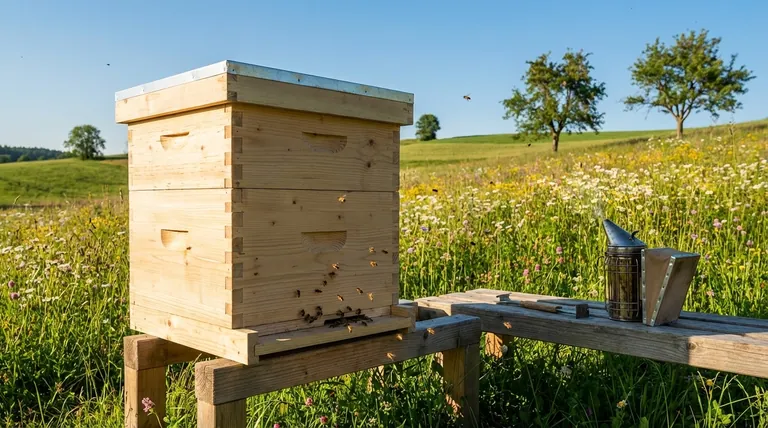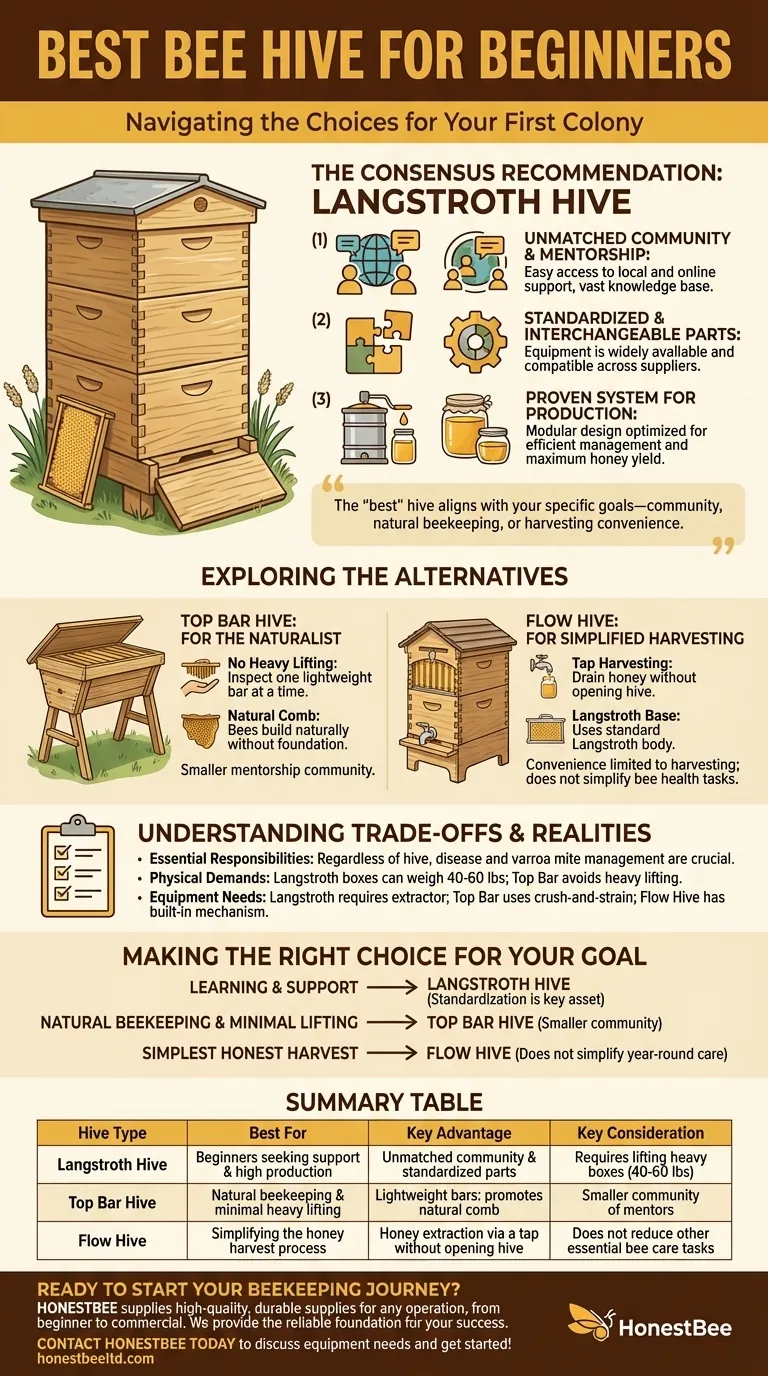For new beekeepers, the consensus recommendation is to begin with a Langstroth hive. Its widespread use means you will have unparalleled access to standardized equipment, educational resources, and experienced mentors who can guide you through your first season.
While the Langstroth hive is the undisputed starting point for its support and standardization, the "best" hive is the one that aligns with your specific goals, be it community support, natural beekeeping, or harvesting convenience.
Why the Langstroth is the Standard for Beginners
The Langstroth hive's design has been the North American standard for over 150 years for several key reasons. It is designed for efficient management and honey production.
Unmatched Community and Mentorship
When you have a question or run into a problem, finding another beekeeper with Langstroth experience is easy. This local and online support system is the most valuable tool a beginner can have.
Standardized and Interchangeable Parts
Every bee supply company sells Langstroth equipment. Boxes (supers), frames, and foundations are built to a standard size, allowing you to buy parts from different suppliers and have them work together seamlessly.
A Proven System for Production
The modular, vertically stacking box design is optimized for honey production. It allows bees to store surplus honey in dedicated boxes (supers) that can be easily removed for harvesting.
Exploring the Alternatives
While the Langstroth is the primary recommendation, understanding other popular hive types helps clarify your own beekeeping philosophy.
The Top Bar Hive: For the Naturalist
The Top Bar hive is a single, long box where bees build their comb naturally, hanging from removable bars. It is fundamentally different from the Langstroth.
This hive is often chosen by beekeepers who want to practice a more "hands-off," natural style of beekeeping. It is also excellent for those who want to avoid heavy lifting, as you only ever inspect or lift one bar at a time, not a full 50-pound box.
The Flow Hive: For Simplified Harvesting
A Flow Hive is essentially a Langstroth hive with special, proprietary frames for honey storage. Its main benefit is saving time and labor during the honey harvest itself.
You can drain honey directly from a tap on the hive without opening it or disturbing the bees. However, this convenience is limited only to the harvesting step.
Understanding the Trade-offs and Realities
Choosing a hive is not just about the box; it's about the entire system of management it requires. No hive eliminates the core responsibilities of beekeeping.
The Myth of the "Easy" Hive
Regardless of your hive choice, you are still responsible for the health of your colony. This includes regular inspections for disease, managing varroa mites, ensuring the queen is healthy, and preventing swarms. A Flow Hive does not reduce these essential tasks.
Equipment and Extraction
With a Langstroth hive, harvesting requires additional equipment like an uncapping knife or fork to remove the wax cappings, and typically an extractor to spin the honey out of the frames. A Top Bar hive requires no special extractor; you simply cut the comb from the bar and crush it to strain the honey. The Flow Hive has the extraction mechanism built-in.
Physical Demands
A standard Langstroth super full of honey can weigh 40-60 pounds. Managing these hives requires the ability to lift and move heavy boxes. The Top Bar hive completely avoids this by using individual bars that weigh only a few pounds each.
Making the Right Choice for Your Goal
Your first hive should set you up for success. Base your decision on your primary motivation for keeping bees.
- If your primary focus is learning quickly with maximum support: Choose the Langstroth hive. Its standardization is your greatest asset.
- If your primary focus is natural beekeeping with minimal heavy lifting: Consider the Top Bar hive, but be prepared to seek out a smaller community of mentors.
- If your primary focus is the simplest possible honey harvest: The Flow Hive delivers on this promise, but remember it does not simplify the overall work of keeping bees healthy year-round.
Ultimately, successful beekeeping comes from understanding bee biology and behavior, a skill you will develop no matter which hive you choose.

Summary Table:
| Hive Type | Best For | Key Advantage | Key Consideration |
|---|---|---|---|
| Langstroth Hive | Beginners seeking support & high production | Unmatched community & standardized parts | Requires lifting heavy boxes (40-60 lbs) |
| Top Bar Hive | Natural beekeeping & minimal heavy lifting | Lightweight bars; promotes natural comb | Smaller community of mentors |
| Flow Hive | Simplifying the honey harvest process | Honey extraction via a tap without opening hive | Does not reduce other essential bee care tasks |
Ready to Start Your Beekeeping Journey?
Choosing the right equipment is the first step to a successful hive. HONESTBEE supplies commercial apiaries and beekeeping equipment distributors with the high-quality, durable supplies needed for any operation, from a beginner's first Langstroth to a large-scale commercial setup.
We provide the reliable foundation for your beekeeping success.
Contact HONESTBEE today to discuss your equipment needs and get started!
Visual Guide

Related Products
- Langstroth Bee Hives Bee Keeping Box for Beginners Beekeeping
- Long Langstroth Style Horizontal Top Bar Hive for Wholesale
- HONESTBEE Advanced Ergonomic Stainless Steel Hive Tool for Beekeeping
- Wholesales Dadant Size Wooden Bee Hives for Beekeeping
- Professional Dual-End Stainless Steel Hive Tool for Beekeeping
People Also Ask
- What is the best type of bee hive for beginners? Start with the Proven Langstroth Standard
- How does the ease of access differ between 8-frame and 10-frame hives? Choose the Right Hive for Your Body
- Why were wooden hives traditionally preferred? For Natural Beekeeping Aligned with Bee Biology
- What are the different types of beehive boxes available? Choose the Right Hive for Your Apiary
- What are the key features of the Langstroth beehive? A Guide to the Standard for Modern Beekeeping



















